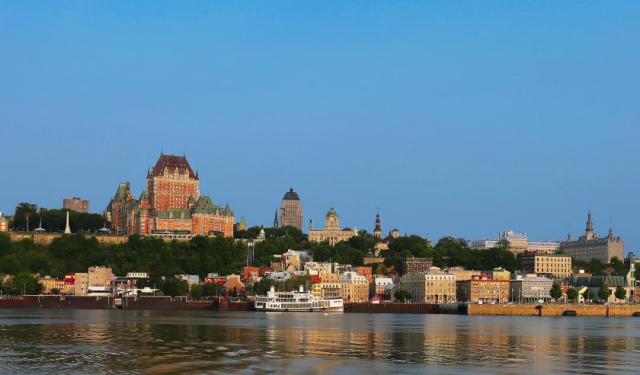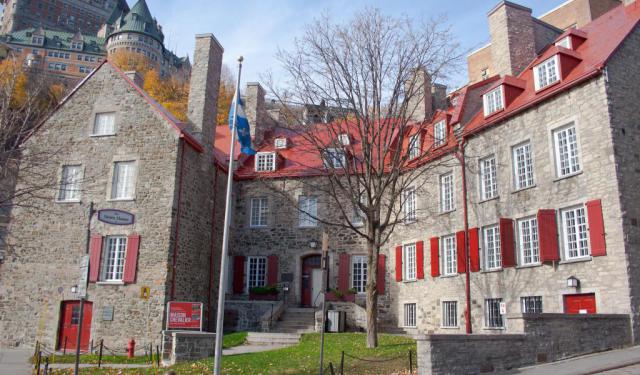
Breakneck Steps (L'Escalier Casse-Cou), Quebec City (must see)
Built in 1635, the legendary Breakneck Stairs or Steps (Escalier Casse-Cou) is the oldest stairway in Quebec City. Named so for its steepness, the staircase was previously known as Champlain Stairs (escalier Champlain), Beggars' Stairs (escalier du Quêteux), and Lower Town Stairs (escalier de la Basse-Ville).
The first steps and landings were made of wood and were much narrower and steeper than today. In 1889, the staircase was replaced with a larger iron one, expanded from a single to three parallel flights, designed by the celebrated local architect and engineer, Charles Baillargé. The stairs that we see now, however, resulted from the major overhaul in the late 1960s.
While not Quebec City's longest staircase (59 steps only), the Breakneck Stairs is probably the city's most useful as it provides a shortcut between Côte de la Montagne street in the Upper Town to the corner of Petit-Champlain and Sous-le-Fort streets in the Lower Town. Despite the ominous name, coined by British tour guides in the mid-19th century (and made official in the 1960s), no serious injuries have ever been reported on the stairs.
The upper level, near Côte de la Montagne, hosts a few artisan kiosks. Tourists adore this location for the wonderful view it affords. As you gaze down upon Petit-Champlain – one of Canada's most picturesque streets, stretching along the foot of the cliff – you may think you are looking at a postcard come to life.
In the winter, the scene is even more sublime with the Christmas lights twinkling and snow gently falling. In the summer, the ultimate experience on the Stairs consists of eating or having a drink at one of the restaurant terraces located on different landings. And when it comes to taking pictures, any time of the year is good, on any of the landings, for a personalized postcard made.
At the bottom of the Stairs, you will find several boutiques, including the famed confectionery La Fudgerie, plus a number restaurants and other delights.
The first steps and landings were made of wood and were much narrower and steeper than today. In 1889, the staircase was replaced with a larger iron one, expanded from a single to three parallel flights, designed by the celebrated local architect and engineer, Charles Baillargé. The stairs that we see now, however, resulted from the major overhaul in the late 1960s.
While not Quebec City's longest staircase (59 steps only), the Breakneck Stairs is probably the city's most useful as it provides a shortcut between Côte de la Montagne street in the Upper Town to the corner of Petit-Champlain and Sous-le-Fort streets in the Lower Town. Despite the ominous name, coined by British tour guides in the mid-19th century (and made official in the 1960s), no serious injuries have ever been reported on the stairs.
The upper level, near Côte de la Montagne, hosts a few artisan kiosks. Tourists adore this location for the wonderful view it affords. As you gaze down upon Petit-Champlain – one of Canada's most picturesque streets, stretching along the foot of the cliff – you may think you are looking at a postcard come to life.
In the winter, the scene is even more sublime with the Christmas lights twinkling and snow gently falling. In the summer, the ultimate experience on the Stairs consists of eating or having a drink at one of the restaurant terraces located on different landings. And when it comes to taking pictures, any time of the year is good, on any of the landings, for a personalized postcard made.
At the bottom of the Stairs, you will find several boutiques, including the famed confectionery La Fudgerie, plus a number restaurants and other delights.
Want to visit this sight? Check out these Self-Guided Walking Tours in Quebec City. Alternatively, you can download the mobile app "GPSmyCity: Walks in 1K+ Cities" from Apple App Store or Google Play Store. The app turns your mobile device to a personal tour guide and it works offline, so no data plan is needed when traveling abroad.
Breakneck Steps (L'Escalier Casse-Cou) on Map
Sight Name: Breakneck Steps (L'Escalier Casse-Cou)
Sight Location: Quebec City, Canada (See walking tours in Quebec City)
Sight Type: Attraction/Landmark
Guide(s) Containing This Sight:
Sight Location: Quebec City, Canada (See walking tours in Quebec City)
Sight Type: Attraction/Landmark
Guide(s) Containing This Sight:
Walking Tours in Quebec City, Quebec
Create Your Own Walk in Quebec City
Creating your own self-guided walk in Quebec City is easy and fun. Choose the city attractions that you want to see and a walk route map will be created just for you. You can even set your hotel as the start point of the walk.
Quebec City Introduction Walking Tour
Cresting a cliff above the St. Lawrence River, Québec City (French: Ville de Québec) is the soul of the province of Québec – a place all its own; a country within a country with its own traditions, architecture, and French-speaking population.
The Algonquian people had originally named the area Kébec, which means "where the river narrows", because the Saint Lawrence River... view more
Tour Duration: 2 Hour(s)
Travel Distance: 3.2 Km or 2 Miles
The Algonquian people had originally named the area Kébec, which means "where the river narrows", because the Saint Lawrence River... view more
Tour Duration: 2 Hour(s)
Travel Distance: 3.2 Km or 2 Miles
Old Quebec Walk
The historic part of Quebec City known as Old Quebec (French: Vieux-Québec), sometimes also referred to as the Latin Quarter (Quartier Latin), is the neighborhood centered around Cape Diamond (Cap Diamant), located on the eastern edge of Quebec hill promontory. The area comprises Upper Town (Haute-Ville) and Lower Town (Basse-Ville) and is currently listed among UNESCO’s World Heritage Sites.
... view more
Tour Duration: 2 Hour(s)
Travel Distance: 2.6 Km or 1.6 Miles
... view more
Tour Duration: 2 Hour(s)
Travel Distance: 2.6 Km or 1.6 Miles
Qucbec City's Historical Churches Walking Tour
The first religious buildings in Canada were established by the Récollets and Jesuits, in 1615 and 1625, respectively, when they first arrived in New France. Later on, the French colonists brought along their culture and architectural traditions, and the establishment of British and evangelical society triggered further major developments in Quebec City.
Over the course of the 17th and 18th... view more
Tour Duration: 2 Hour(s)
Travel Distance: 2.9 Km or 1.8 Miles
Over the course of the 17th and 18th... view more
Tour Duration: 2 Hour(s)
Travel Distance: 2.9 Km or 1.8 Miles
Historical Houses Walking Tour
Quebec City, particularly evocative of Europe in its atmosphere, is often referred to as the cradle of New France. The city boasts one of the richest architectural heritages in North America, though most of its buildings had to be adapted to harsh winters and the lack of specialized workers and materials in the colony. As such, the majority of local houses were designed as simple and efficient... view more
Tour Duration: 2 Hour(s)
Travel Distance: 2.5 Km or 1.6 Miles
Tour Duration: 2 Hour(s)
Travel Distance: 2.5 Km or 1.6 Miles




